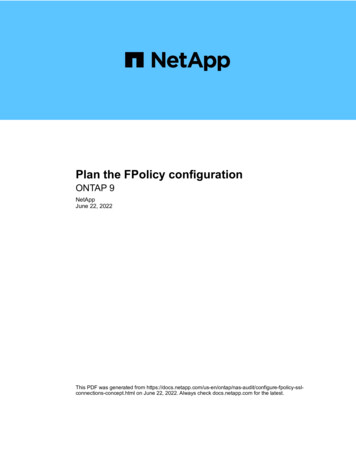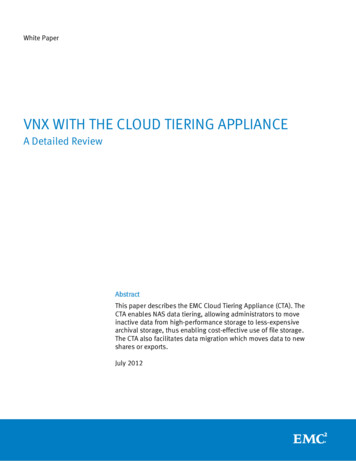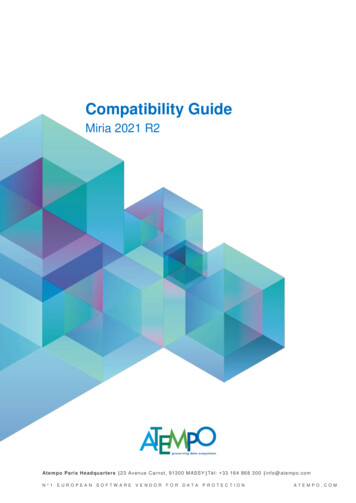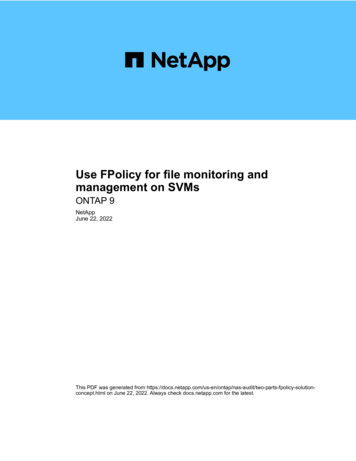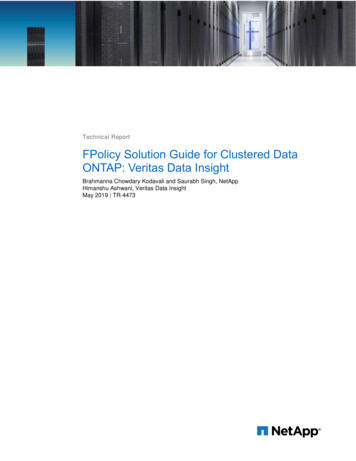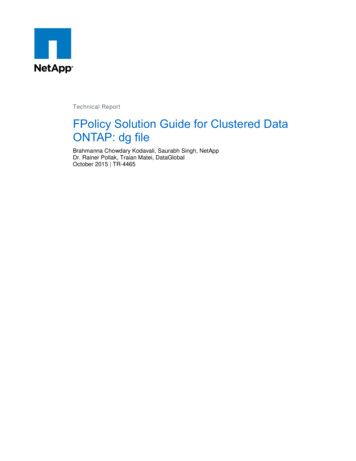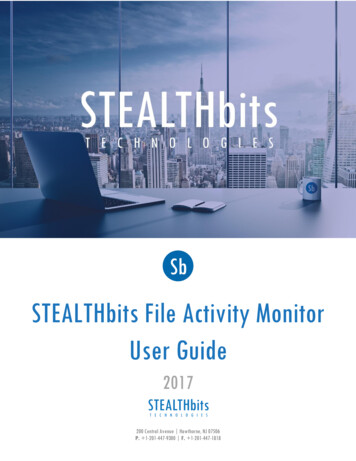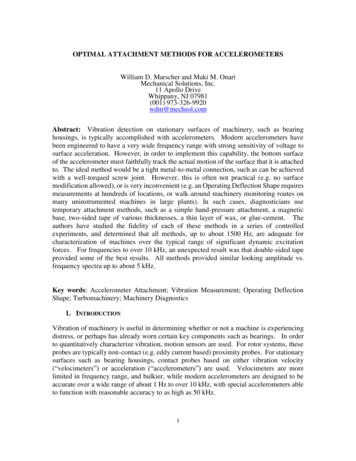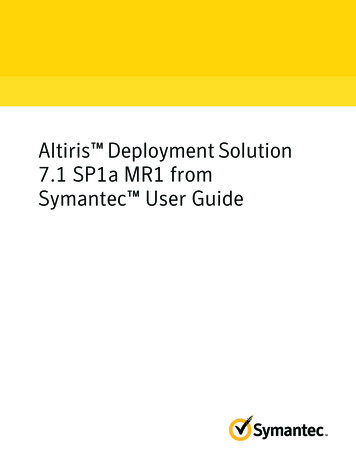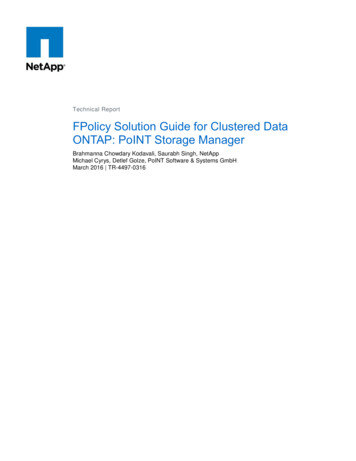
Transcription
Technical ReportFPolicy Solution Guide for Clustered DataONTAP: PoINT Storage ManagerBrahmanna Chowdary Kodavali, Saurabh Singh, NetAppMichael Cyrys, Detlef Golze, PoINT Software & Systems GmbHMarch 2016 TR-4497-0316
TABLE OF CONTENTS12345Introduction . 41.1Audience .41.2Purpose and Scope .4FPolicy Overview . 42.1Role of Clustered Data ONTAP Components in FPolicy Configuration .52.2How FPolicy Works with External FPolicy Servers .5FPolicy Solution Architecture . 63.1FPolicy Components in Clustered Data ONTAP .63.2FPolicy Application Software—PoINT Storage Manager .7Installing and Configuring PoINT Storage Manager . 74.1PoINT Storage Manager Requirements and Installation Procedure .74.2Configuration of PoINT Storage Manager for NetApp .7FPolicy Configuration in Clustered Data ONTAP . 135.1FPolicy Configuration Workflow .135.2Create an FPolicy Event .145.3Create an FPolicy External Engine .145.4Create an FPolicy Policy .155.5Create an FPolicy Scope .155.6Enable the FPolicy Policy.166Security Login Configuration for FPolicy Server . 167Clustered Data ONTAP Best Practices . 178927.1Policy Configuration .177.2Network Configuration .177.3Hardware Configuration .177.4Multiple Policy Configuration .177.5Managing FPolicy Workflow and Dependency on Other Technologies .187.6Sizing Considerations .18PoINT Storage Manager Best Practices . 188.1Changing the FPolicy Configuration .188.2Volume Junction Paths .188.3NetApp Snapshot Copies .19Troubleshooting Common Problems . 19FPolicy Solution Guide for Clustered Data ONTAP: PoINT Storage Manager 2016 NetApp, Inc. All rights reserved.
9.1Problem: FPolicy Server Is Disconnected .199.2Problem: FPolicy Server Does Not Connect .199.3Problem: External Engine Is Not Native for Policy .209.4Problem: Notifications Are Not Received for File Operations on Volume, Share, and Export .2010 Performance Monitoring . 2010.1 Collect and Display FPolicy Counters .2110.2 Counters to Be Monitored .21LIST OF TABLESTable 1) FPolicy event options. .14Table 2) FPolicy external engine options.15Table 3) FPolicy policy options. .15Table 4) FPolicy scope options. .16Table 5) FPolicy counters. .21Table 6) FPolicy server counters. .21LIST OF FIGURESFigure 1) FPolicy solution architecture. .6Figure 2) FPolicy configuration workflow. .133FPolicy Solution Guide for Clustered Data ONTAP: PoINT Storage Manager 2016 NetApp, Inc. All rights reserved.
1 Introduction The NetApp FPolicy component is a file-access-notification system that enables an administrator tomonitor file access in storage configured for Network File System (NFS) and CIFS. Introduced for the scaled-out architecture in the NetApp clustered Data ONTAP 8.2 operating system, FPolicy enables arich set of use cases working with selected NetApp partners. FPolicy requires all nodes in a cluster to runData ONTAP 8.2 or later. The system supports all SMB versions, including SMB 1.0 (CIFS), SMB 2.0,SMB 2.1, and SMB 3.0. FPolicy also supports major NFS versions, including NFSv3 and NFSv4.0.FPolicy natively supports a simple file-blocking use case that enables administrators to restrict end usersfrom storing unwanted files. For example, an administrator can block the storage of audio and video filesin data centers and thus save precious storage resources. This feature blocks files based only onextension; for more advanced features, partner solutions should be considered.This system enables partners to develop applications that cater to a diverse set of use cases, includingbut not limited to: File screening File-access reporting User and directory quotas Hierarchical storage management and archiving solutions File replication Data governance1.1AudienceThis document is for customers who want to implement a HSM and archiving solution for clustered DataONTAP storage systems.1.2Purpose and ScopeThis document explains the FPolicy framework. It also describes the steps required to deploy an HSMand archiving solution using PoINT Storage Manager. The scope of the document encompassesdeployment procedures and best practices for the solution.2 FPolicy OverviewThe Data ONTAP FPolicy framework creates and maintains the FPolicy configuration, monitors file eventsresulting from client access, and sends notifications to external FPolicy servers. Communication betweenthe storage node and the external FPolicy servers is either synchronous or asynchronous. The use ofsynchronous or asynchronous communication depends on whether the FPolicy framework expects anotification response from the FPolicy server.Synchronous notification is suitable for use cases in which Data ONTAP allows or denies client accessbased on the notification response from the FPolicy server. Use cases such as quotas, file screening, filearchiving recall, and replication require synchronous notification.Asynchronous notification is suitable for use cases such as monitoring and auditing file-access activitythat do not require Data ONTAP to take action based on the notification response from the FPolicyserver. In these cases, Data ONTAP does not need to wait for a response from the FPolicy server.4FPolicy Solution Guide for Clustered Data ONTAP: PoINT Storage Manager 2016 NetApp, Inc. All rights reserved.
2.1Role of Clustered Data ONTAP Components in FPolicy ConfigurationThe following components play a role in FPolicy configuration: Administrative SVM. The administrative storage virtual machine (SVM, called Vserver in the DataONTAP CLI and GUI) contains the FPolicy management framework. It maintains and manages theinformation about all FPolicy configurations in the cluster. Data SVMs. FPolicy configuration can be defined at the level of the cluster or the SVM. The scopedefines the resources to be monitored in the context of an SVM. It operates only on SVM resources.One SVM configuration cannot monitor and send notifications for the data (shares) belonging toanother SVM. However, FPolicy configurations defined on the administrative SVM can be leveragedin all data SVMs. Data LIFs. FPolicy server connections are made through data logical interfaces (LIFs) that belong tothe data SVM containing the central FPolicy configuration. The data LIFs used for these connectionscan fail over in the same manner as data LIFs used for normal client access.2.2How FPolicy Works with External FPolicy ServersFPolicy runs on every node in the cluster. It is responsible for establishing and maintaining connectionswith external FPolicy servers. As part of its connection management activities, the FPolicy frameworkhandles many management tasks: Controls the flow of file notifications through the correct LIF to the FPolicy server Load-balances notifications to the FPolicy server if multiple FPolicy servers are associated with apolicy Tries to reestablish the connection when a connection to an FPolicy server is broken Sends notifications to FPolicy servers during an authenticated session Establishes a connection with the data LIFs on all nodes participating in the SVMFor synchronous use cases, the FPolicy server accesses data on the SVM through a privileged dataaccess path. Data ONTAP secures this path by combining specific user credentials with the FPolicyserver IP address that was assigned during FPolicy configuration. After FPolicy is enabled, the usercredentials included in the FPolicy configuration are granted the following special privileges in the filesystem: Ability to bypass permission checks when accessing data, enabling the user to avoid checks on filesand directory access Special locking privileges through which Data ONTAP allows the FPolicy server to read, write, ormodify access to any file regardless of existing locksNote: If the FPolicy server creates byte-range locks on the file, existing locks on the file are immediatelyremoved. Ability to bypass any FPolicy checks so that file access over a privileged data path does not generatean FPolicy notificationFor more information about FPolicy functionality, see the Clustered Data ONTAP 8.3 File AccessManagement Guide for CIFS on the NetApp Support site.5FPolicy Solution Guide for Clustered Data ONTAP: PoINT Storage Manager 2016 NetApp, Inc. All rights reserved.
3 FPolicy Solution ArchitectureThe FPolicy solution consists of the clustered Data ONTAP FPolicy framework and the FPolicyapplication Veritas Data Insight. Figure 1 shows the architecture of the solution.Figure 1) FPolicy solution architecture.NFSCIFSFPolicyThe FPolicy application software is installed on a server running Windows Server; the FPolicy frameworkexists in clustered Data ONTAP. The FPolicy framework connects to external FPolicy servers. It sendsnotifications for certain file system events to the FPolicy servers when these events occur as a result ofclient access. The external FPolicy servers process the notifications and send responses back to thenode.3.1FPolicy Components in Clustered Data ONTAPThe FPolicy framework in clustered Data ONTAP includes the following components: External engine. This container manages external communication with the FPolicy serverapplication. Events. This container captures information about protocols and file operations monitored for thepolicy. Policy. This primary container associates different constituents of the policy and provides a platformfor policy-management functions such as policy enabling and disabling. Scope. This container defines the storage objects on which the policy acts; examples includevolumes, shares, exports, and file extensions.6FPolicy Solution Guide for Clustered Data ONTAP: PoINT Storage Manager 2016 NetApp, Inc. All rights reserved.
3.2FPolicy Application Software—PoINT Storage ManagerPoINT Storage Manager is a universal storage management software solution that supports anautomated tiered storage architecture, and it incorporates the capabilities and advantages of differentstorage technologies. The software provides a solution for automated and secure long-term archiving ofdata that is stored in a company’s IT infrastructure. The product was also especially designed for theseamless data migration from obsolete “legacy” storage systems to new systems with state-of-the-arttechnologies.4 Installing and Configuring PoINT Storage Manager4.1PoINT Storage Manager Requirements and Installation ProcedurePoINT Storage Manager requires the following hardware and software: x86-based system with at least one quad-core processor and at least 8GB RAM Operating systems: Windows Server 2012 and 2012 R2 (Standard, Datacenter), Windows Server2008 R2 SP1For additional information, see the PoINT Storage Manager manual and the ReadMe.html file that areincluded with the distribution package of PoINT Storage Manager.To install PoINT Storage Manager, run the setup.exe from the root folder of the distribution packageand follow the instructions. After installation, the setup wizard starts and guides you through the basicconfiguration. For more information about the basic configuration, see the PoINT Storage Managermanual.Depending on the device that you configured as the archival device, you must install a correspondingconnector for this device. The connectors are located in the Connectors folder of the distribution package. For example, to use a NetApp StorageGRID Webscale appliance, you must install theconnector from the Webscale subdirectory.To install a connector, double-click the .exe file and follow the instructions.You also must install the PoINT NetApp FPolicy Server for Cluster Mode module, which is providedseparately from the PoINT Storage Manager distribution package. To install this module, double-click thecorresponding .exe file and follow the instructions.4.2Configuration of PoINT Storage Manager for NetAppThe configuration of PoINT Storage Manager consists of the following steps:1. Configuration of an archival device2. Creation of a storage vault and an archival policyConfigure an Archival DeviceTo configure an archival device, complete the following steps:1. Select Setup PoINT Storage Manager and click Archive Devices. The Add/Remove Devices dialogbox appears.2. Select the type of archival device by clicking the corresponding button.For example, if you want to add a network share on a NetApp FAS system as archival storage, selectHard Disk/NAS in this dialog box. Select NetApp Storage in the next dialog box and then specify thenetwork share to use.The following steps demonstrate how to configure NetApp StorageGRID Webscale as an archival device:7FPolicy Solution Guide for Clustered Data ONTAP: PoINT Storage Manager 2016 NetApp, Inc. All rights reserved.
1. In PoINT Storage Manager Setup, under Archive Devices, click Object Store.2. Select NetApp StorageGRID Webscale from the Advanced Connectors drop-down menu and clickNext.3. Enter a device name and click Edit to open the configuration string editor.8FPolicy Solution Guide for Clustered Data ONTAP: PoINT Storage Manager 2016 NetApp, Inc. All rights reserved.
4. Enter the required information in the Value fields and click OK.5. Click Create to complete the configuration of the archival device and then click OK to exit the PoINTStorage Manager Setup wizard.Create a Storage Vault and Archival PolicyTo create a storage vault, complete the following steps:1. Click Create Storage Vault to start the Storage Vault configuration wizard.9FPolicy Solution Guide for Clustered Data ONTAP: PoINT Storage Manager 2016 NetApp, Inc. All rights reserved.
2. Enter a name for the storage vault and select NetApp FAS (Cluster Mode) and click Next.3. In the Performance Tier dialog box, under Data Sources, click Add to specify the folder that contains the data that you want to archive. You are also prompted to enter a NetApp ONTAPI login. Forinformation about the requirements for the ONTAPI login, see the ReadMe.pdf document of thePoINT NetApp FPolicy Server for Cluster Mode module.4. Click Next twice to skip configuration of a capacity tier and to select the Archive Tier configurationdialog box.10FPolicy Solution Guide for Clustered Data ONTAP: PoINT Storage Manager 2016 NetApp, Inc. All rights reserved.
5. Under Archive Devices, click Add to add the archival device that you configured previously.6. Click Next to configure the archival policy.7. Under Archive Policies, click Add to open the archival polices editor.8. From the drop-down menu, select Archive New and Changed Files and click OK. This predefinedpolicy archives all new and changed files since the last archiving job cycle.11FPolicy Solution Guide for Clustered Data ONTAP: PoINT Storage Manager 2016 NetApp, Inc. All rights reserved.
9. Click Add again to add the policy and then select Purge Archived Files Which Have Not BeenAccessed for a Time. This predefined policy replaces archived files on the performance tier by "stubs"according to the selected conditions.10. Set a schedule according to your requirements. You can always execute an archiving job cyclemanually.12FPolicy Solution Guide for Clustered Data ONTAP: PoINT Storage Manager 2016 NetApp, Inc. All rights reserved.
11. Click Create to complete the storage vault configuration. The archiving job cycle will start at thescheduled time or when you manually trigger the job cycle by clicking the green arrow icon.For information about more advanced functionality of PoINT Storage Manager, see the productdocumentation in the installation package or on http://www.point.de.5 FPolicy Configuration in Clustered Data ONTAPThis section provides instructions for configuring FPolicy for NetApp file servers running clustered DataONTAP. The FPolicy structure includes the following components: Event. Defines which operations and protocol types FPolicy audits. External engine. Defines the endpoint to which FPolicy sends notification information. Policy. Provides the aggregation of events policy, external engine, and scope. Scope. Defines the volumes, shares, export policies, and file extensions to which the FPolicy policyapplies. It also allows you to include and exclude all relevant filters.Configuration Requirements The shares must reside on the volume monitored for CIFS events. The export policy must be created on and applied to the volume monitored for NFS events.5.1FPolicy Configuration WorkflowFigure 2 shows the workflow for creating a resident policy. Before you create a policy, you should createan external engine and an event. After you define a policy, you must associate a scope with it.After the scope is created, the policy must be enabled with a sequence number. The sequence numberhelps to define the policy’s priority in a multi policy environment, with 1 having the highest priority and 10having the lowest.Figure 2) FPolicy configuration workflow.13FPolicy Solution Guide for Clustered Data ONTAP: PoINT Storage Manager 2016 NetApp, Inc. All rights reserved.
Important NotePoINT Storage Manager automatically performs the FPolicy configuration. You are not required tomodify this configuration, and NetApp does not recommend that you modify it.Sections 5.2 through 5.6 explain the commands and APIs that the application uses in the backgroundto configure the different components. These commands are included in this TR for reference only.PoINT Storage Manager recommends automatic configuration of the FPolicy options by theapplication. It does not recommend making any manual configurations.If necessary, you can use the show commands in each section to compare the automatic FPolicyconfiguration.5.2Create an FPolicy EventTo enable an external application to connect to a NetApp storage device that runs clustered DataONTAP, you must configure an FPolicy policy for it. To do so, you must be a user with the vsadmin roleand must have a user name that is associated with the NetApp ONTAPI application.To create an FPolicy event by using TCP, complete the following steps:1. Connect to the NetApp Data ONTAP management console through Secure Shell.2. To create and verify an FPolicy event object that monitors CIFS requests, run the following command:fpolicy policy event create -vserver vserver name -event-name event name -file-operationsclose, write, read, setattr –filters offline bit -protocol cifsTable 1 lists the options for the FPolicy event.Table 1) FPolicy event options.OptionDescription-vserverThe name of the Vserver on which you want to create an FPolicy-event-nameThe name of the FPolicy event that you want to create-file-operationsThe file operations for the FPolicy eventPossible values: create, create dir, delete, delete dir, read,write, close, rename, rename dir-protocolThe name of the protocol for which the event is createdPossible value: cifs, nfsv3, nfsv4-filtersThe filters used with a given file operation for the protocol specified in the-protocol parameterExamples: first-read, close-with-modificationTo view the event object, run the following command:fpolicy policy event show event name –instance5.3Create an FPolicy External EngineTo manually create an FPolicy external engine, run the following command:fpolicy policy external-engine create –vserver vserver name -engine-name engine-name –primary14FPolicy Solution Guide for Clustered Data ONTAP: PoINT Storage Manager 2016 NetApp, Inc. All rights reserved.
servers ip address of Fpolicy server -port port used by PoINT Storage Manager -extern-enginetype synchronous –ssl-option no-authTable 2 lists the options for the FPolicy external engine.Table 2) FPolicy external engine options.OptionDescription-vserverThe name of the SVM (Vserver) on which you want to create an FPolicy externalengine-engine-nameThe name of the external engine that you want to create-primary-serversThe IP addresses for the primary FPolicy servers-portThe port number for the FPolicy service (PoINT Storage Manager uses 8632)-extern-enginetypeThe type of external engine-ssl-optionThe SSL option for external communication with the FPolicy serverPossible values: server-auth. Provides FPolicy server authentication. mutual-auth. Provides both FPolicy server and NetApp authentication.Note: Only synchronous external engine communication is supported.To view the external engine or engines that you created, run the following command:FPolicy policy external-engine show5.4Create an FPolicy PolicyTo manually create an FPolicy policy, run the following command:fpolicy policy create -vserver vserver name -policy-name policy name -events event name -engine engine name -is-mandatory trueTable 3 lists the policy options for FPolicy.Table 3) FPolicy policy options.OptionDescription-vserverThe name of the SVM (Vserver) on which you want to enable FPolicy-policy-nameThe name of the FPolicy policy that you want to create-eventsA list of events to monitor for the FPolicy policy-engineThe name of the external engine that you want to create-is-mandatoryDetermines whether the FPolicy object is mandatoryTo view the policy that you created, run the following command:fpolicy policy show5.5Create an FPolicy ScopeTo manually create the FPolicy scope, run the following command:15FPolicy Solution Guide for Clustered Data ONTAP: PoINT Storage Manager 2016 NetApp, Inc. All rights reserved.
fpolicy policy scope create -vserver vserver name -policy-name policy name -volumes-toinclude "*" -export-policies-to-include "*"Table 4 lists the options for the FPolicy scope.Table 4) FPolicy scope options.OptionDescription-vserverThe name of the SVM (Vserver) on which you want to enable FPolicy-policy-nameThe name of the FPolicy policy that you want to create-volumes-toincludeA comma-separated list of volumes to be monitored-export-policiesto-includeA comma-separated list of export policies for monitoring file accessNote: Wildcards are supported.To view the FPolicy scope that you created, run the following command:fpolicy policy scope show -vserver vserver name - policy-name policy name 5.6Enable the FPolicy PolicyRun the following command to manually enable the new FPolicy policy:fpolicy policy enable -vserver vserver name -policy-name policy name –sequence-number seqno 6 Security Login Configuration for FPolicy ServerDuring configuration of a Storage Vault in PoINT Storage Manager you will be prompted for the ONTAPIlogin credentials, which will be used by the PoINT NetApp FPolicy Server to connect to the SVM. This login should be created on the SVM by using the NetApp command shell or NetApp OnCommandSystem Manager. It is not necessary to create a related Windows or domain account.Command example:security login create -username username -vserver Vserver Name -application ontapi authmethod passwd -role vsadminThe login credentials through ONTAPI should be assigned the vsadmin role with its associated password.If there is any restriction in providing vsadmin role to the user, a new role can be created which providesat least the following permissions: version: readonly volume: readonly vserver: readonly vserver fpolicy: allNote:16Note that all Storage Vaults on a SVM must use the same login credentials.FPolicy Solution Guide for Clustered Data ONTAP: PoINT Storage Manager 2016 NetApp, Inc. All rights reserved.
7 Clustered Data ONTAP Best PracticesNetApp recommends following FPolicy best practices for server hardware, operating systems, patches,and so on.7.1Policy ConfigurationConfiguration of an FPolicy External Engine for the SVMProviding additional security comes with a performance cost. Enabling SSL communication will have aperformance effect on CIFS.Configuration of FPolicy Events for the SVMMonitoring file operations has an effect on the overall user experience. In fact, filtering unwanted fileoperations on the storage side improves the overall user experience. NetApp recommends monitoring theminimum number of file operations and enabling the maximum number of filters without breaking the usecase. The CIFS home directory environment has a high percentage of getattr, read, write, open,and close operations. NetApp recommends the use of filters for these operations. For recommendedfilters, see the section “Create an FPolicy Event.”Configuration of an FPolicy Scope for the SVMYou should confine the scope of the policies to relevant storage objects, such as shares, volumes, andexports, rather than enabling them throughout the SVM. NetApp recommends checking directoryextensions. If is-file-extension-check-on-directories-enabled is set to true, then directoryobjects are subjected to the same extension checks as regular files.7.2Network ConfigurationNetwork connectivity between the NetApp FPolicy server and the controller should be of low latency.NetApp recommends separating FPolicy traffic from client traffic by using a private network.NoteIn a scenario in which the LIF for FPolicy traffic is configured on a different port from the LIF for client traffic,a port failure might cause the FPolicy LIF to fail over to another node. This action makes the FPolicy serverunreachable from t
The NetApp FPolicy component is a file-access-notification system that enables an administrator to monitor file access in storage configured for Network File System (NFS) and CIFS. Introduced for the
